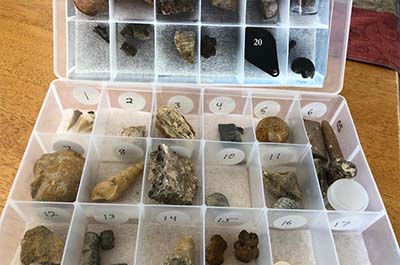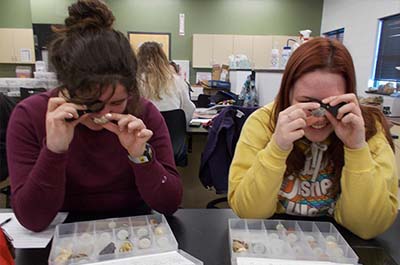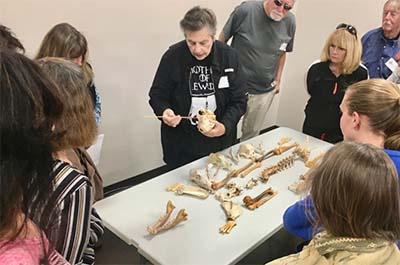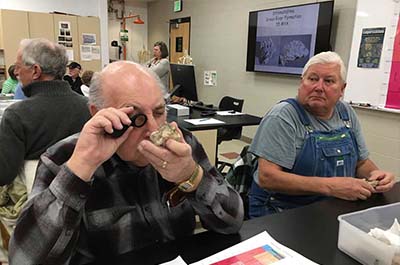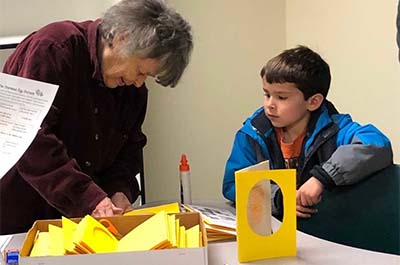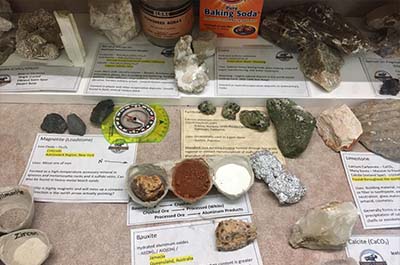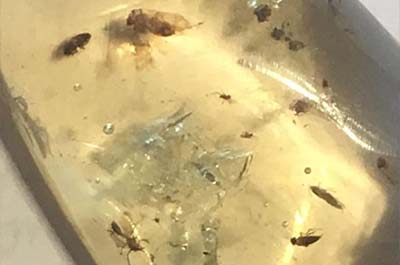Everything Begins With Mining
by Cindy Smith
Steve Wolfe’s “Everything Begins with Minerals” display at PCC
A fascinating display of all colors and compositions.
There are many ways to appreciate rocks. Many of us notice them simply for their color, texture and shape, irresistible and raw in nature. We love the heat of the rough sandstone under our bare feet on a hot day, or the way those flat stones skip across the Arkansas. We feel grateful for the cairn that guides us safely along a foggy trail. Yet how often do we acknowledge the hidden influence rocks have in our daily lives? Everything we use to communicate, travel, work, play, all the mundane and extravagant items we require daily are available to us only because they come from the rocks beneath our feet.
It was during my first visit to the Western Museum of Mining and Industry north of Colorado Springs where I studied a display explaining that everything in my life – in my home, my car, at my work – everything on the planet comes from the landscape beneath our feet. That’s when I began to respect the lowly rock.
There is a new display case in the Learning Resource Room at PCC, put together by Steve Wolfe, exhibiting many of our natural resources found in Fremont County, but Steve’s exhibit takes us a step further, showing how we use these minerals from our back yard in our daily lives.
Check out north on the compass sitting next to a lump of magnetite. Amaze at the transparency of the large plate of muscovite mica (white mica), and compare it with biotite mica (black mica). Marvel at the neon of malachite and azurite, both copper ores. Compare 5 types of common quartz: milky, smoky, rose, amethyst, chalcedony.
Find the most important ore making up titanium. Which is the softest mineral on display? (Hint – your kids use it everyday in school). What mineral makes up the white pigment in paints and cosmetics? Note the stages bauxite ore goes through before it becomes the aluminum we know so well. How many uses can you name for silver before going to see the display? In what ordinary-looking ore do you find diamonds? What mineral played a role in US politics with South Africa in the 70’s and 80’s?
And what’s the mineral we couldn’t live without, the ubiquitous one that comes from the Climax Mine near Leadville?
How ordinary these extraordinary rocks look – without them we would have no cell phones, no computers, no transportation, no anything. Take a look at the display and consider rocks in a new dimension.
For more information on Fremont County geology, read Steve’s 1991 thesis “The Natural History of Fremont County, CO”, available at the John C. Fremont Library in Florence.
More Articles from “Stones ‘n’ Bones Activities”
Fossil Boot Camp – Covid Style
Stones ‘n Bones of Fremont County traditionally presents two or three Fossil Boot Camp classes each year for school age students and adults. With COVID, that has proven a little difficult
Fossil Boot Camp for PCC Historical Geology Students
Fremont Stones ‘n Bones introduced 16 Pueblo Community College students to fossils in Steve Wolfe’s Historical Geology class.
Stones ‘n’ Bones With Villa Bella School’s 2nd Graders
“What do paleontologists do?” is the question we were asked to help answer for 50 second graders at Pueblo, Colorado’s newest elementary school on January 16, 2020.
The Close Relationship Between Man & Dog
Dr. Sue Ware returned to the Royal Gorge Dinosaur Experience for the second time, to the delight of 27 community members. She presented a program entitled “From your Campfire to your Bed: The Evolution, Importance & Relationship between Dogs and Humans”.
Fossil Boot Camp at PCC Mini-College
For the 5th straight year, Stones ‘n Bones presented Fossil Boot Camp to 31 senior citizens in the Fremont County community.
Stones ‘n’ Bones & the Enormous Egg
What happens when an entire elementary school reads the same book, The Enormous Egg, and asks Fremont County Stones and Bones to come in to help with the family night to celebrate the reading? A two-hour evening full of paleontology learning!
Introducing Geology Students to Fossils
How does Steve Wolfe, Historical Geology instructor at PCC-Fremont Campus, prepare his students for field season observations? One way is by introducing them to fossils
Identifying Trilobites
The Pioche Formation of eastern Nevada is world famous for its amazing preservation of trilobites. Very old trilobites, from the Lower Cambrian (542 – 521 million years old), almost the oldest on record.
Everything Begins With Mining
There are many ways to appreciate rocks. Many of us notice them simply for their color, texture and shape, irresistible and raw in nature.
Insects Trapped in Amber
Many of us are familiar with the high preservation of insects and leaves in the Green River Formation, a Colorado lagerstätte well known for field trips yielding magnificent fossils.

